Split Fish Market Reveals Unusual Mantis Shrimp Never-Before-Seen in Adriatic
January 29, 2021 - One fishmonger at the Split Fish Market caught an unusual creature in the Adriatic this week, a type of Mantis shrimp never-before-seen in the Adriatic, at least according to official data.
"Yesterday, we had the opportunity to get acquainted with the type of mantis shrimp (Stomatopod). This species normally lives in the Atlantic and very rarely is seen in the Mediterranean. And here it is, for the first time in the Adriatic," reads the Split Fish Market Facebook page, as reported by 24 Sata.
Little is known about this species, they say, and this discovery will certainly help detect it in the future.
"The creature in question was caught in front of Rogoznica at some 80/100 meters depth with the MARETA 1 trawl. Since we assumed that it was rare, we contacted the Institute of Fisheries and Oceanography, which immediately collected it and took it for additional analysis and research. After that, it will be placed in the Natural History Museum in Rijeka," the Split Fish Market added.
Experts claim that it is Parasquilla ferussaci, a mantis shrimp from the Parasquillidae family. It was first discovered in 1928.
This rare species lives at depths of 100 to 800 meters and had not been recorded in the Adriatic so far.
Considering that it was discovered here for the first time, the creature does not yet have a Croatian name. The Split Fish Market asked their followers for help in coming up with a name for the new species.
"Our task today is to give it a Croatian name because it does not have one, since it has never been caught here... Let's have a little imagination," they concluded.
What do you think it should be called? Comment on the Split Fish Market Facebook post and see the unique answers so far!
To read more about lifestyle in Croatia, follow TCN's dedicated page.
On the Edge of Peskarija: October Exhibition Brings Life Back to Split City Center
October 8, 2020 - The small Split fish restaurant PiNKU fish & wine is organizing a series of outdoor photo and illustration exhibitions entitled 'On the Edge of Peskarija.' The exhibition space is located in the north-eastern part of the Split fish market facade, and the idea is for the exhibition to be shown to all passers-by and visitors, every day from October 9 to 30, 2020.
"The intention is to promote the city of Split's cultural scene and to revive cultural events in the open space in the city center. Given the new global and local situation, in recent years when the city center would be quite empty and deserted in winter, this event is a kind of revival of interesting and important city locations, and the desire to turn them into a gallery for a short period," said the organizer Frane Delic.
The Split fish market position and its importance to the people, along with the already defined and interesting gastronomic ensemble on Obrov Street, close the circle of the positive ambiance of a city micro-location. The project will feature works by three Split photographers and illustrators - Pero Ugarkovic, Fedja Klaric, and Mile Modic. Each exhibition will be set for a week, and the first this Friday at 8 pm. Each exhibition opening on Friday will be accompanied by a DJ selection of Split musicians.
"The somewhat easygoing concept that PiNKU promotes through its gastronomic story, accompanied by the works of the mentioned artists that we have not been able to see in such an edition so far, defines the name of this event which takes place literally on the 'edge' of the Split fish market, or 'Peskarija,'" Delic concluded.
Thus, this Friday, October 9, the first exhibition is by Pero Ugarkovic, titled 'Crabs of the Adriatic', will begin at 8 pm. The music is selected by Branko Dragicevic a.k.a. Fog Valentino Frog Boskovic Dog.

Pero Ugarkovic, a passionate underwater lover, is the author of many texts on marine topics, the editor of the popular Facebook page podvodni.hr, a collaborator and co-author of various scientific articles, and a persistent promoter of science.
Since birth, he has been observing the marine world, emphasizing behavioral and population ecology and the systematics of the Adriatic fauna. Relatively recently, with the help of enthusiastic friends, he became additionally interested in malacology (the science of mollusks), which prompted him to document and photograph beautiful and interesting creatures living near us.
This photographic exhibition of images of crabs also resulted from that.
He devotedly searched for all the photographed samples from the shallows of the Split beaches to great depths, and after photographing them, he returned them to the sea carefully and unharmed.
So far, he has photographed more than 100 different mollusks, worms, and crabs ... some of them are new to the Adriatic Sea and science in general.
Contrary to many opinions, the Adriatic Sea is very rich in marine life. What most of our citizens know are large and commercially important species, when in fact, the true number of smaller species of many classes of animals is not known to us, and we probably won’t know for a long time what all lives in our sea.
Projects like this are one way to explore the coast that will improve our knowledge and overall Croatian biology. The exhibition aims to introduce visitors to the fascinating sea creatures that live next to us - our fellow citizens.
Source: Dalmatinki Portal, Facebook event
For the latest travel info, bookmark our main travel info article, which is updated daily.
Read the Croatian Travel Update in your language - now available in 24 languages.
Join the Total Croatia Travel INFO Viber community.
Green Markets and Fish Market Re-open in Split Today Under Strict Rules
April 9, 2020 - The outdoor green markets and the fish market in Split will re-open today, though under strict measures by the National Civil Protection Headquarters and Ministry of Agriculture.
The National Civil Protection Headquarters issued a Decision on Market Operations during the coronavirus pandemic. In compliance with the special measures and instructions of the Public Health Institute of Split, the famous Pazar, Sućidar market and the market in Split 3, as well as the fish market, are open from today.
On Tuesday, all the conditions of the National Headquarters and the Public Health Institute were respected, which means that during the operation of all markets, the entrance will be controlled and, if necessary, the number of people will be limited, in order to ensure a minimum distance between citizens. Also, the buyer will not come in contact with the products, as there will be a barricade.
Measures of enhanced hygiene and daily cleaning of all premises will be applied, the enclosed areas will be ventilated regularly, and checkpoints with hand sanitizers are provided, with information on general measures to reduce the risk of infectious diseases.
"The Ministry of Agriculture states that the decision allows, subject to a strict measure of social distance, the operation of closed facilities (shops and kiosks) in the markets selling food, medicines, hygiene items, veterinary medicinal products, agricultural medicines and animal feed and sales places (benches) in markets that are closed facilities or enclosures and sell fish, milk and dairy products and fruits and vegetables," according to the Ministry on T.portal.
The retail sale of fruit, vegetables and flowers from vehicles in enclosures is allowed, according to the principles of the green market.
Legal or natural persons managing the markets are obliged, in addition to the measures and instructions prescribed by the Croatian Institute of Public Health, to additionally secure the entrance and exit of a limited number of customers, and to set up barriers or plexiglass protection at points of sale (benches), in order to reduce physical contact and maintain a prescribed distance of 3 to 5 meters between the seller and the buyer. The specified distance of 3 to 5 meters must also be maintained between the customers located in the market area.
Also, sales from vehicles imply safety distances of at least 3 meters between vehicles that are points of sale and between vehicles of customers. Sales of products from vehicles must be organized in such a way as to prepare the packaging in advance so that customers can stay as quickly as possible at the point of sale, the statement added.
In addition to the measures and instructions prescribed by the Croatian Institute of Public Health, it should be ensured that no crowds are created at the entrances and inside the premises, clear instructions are given and made visible at entrances and market premises, enhanced hygiene measures are applied, and all areas must be cleaned and ventilated daily. Workers and customers must observe a strict measure of social distance, provide checkpoints with hand sanitizers, and prominently display notice of general reduction measures for infectious disease risks, and instructions and recommendations for adhering to the general rules on hygiene.
The City of Split asks citizens to respect all anti-pandemic measures when they arrive at the green markets and fish market today.
Split Fish Market Celebrates 130 Years with First Closure in History
April 1, 2020 - On Tuesday, March 31st, the Split fish market celebrated its 130th birthday.
The special birthday was welcomed closed, for the first time in history, a scenario that only a few could have imagined just a few weeks ago.
Slobodna Dalmacija writes that while we can no longer buy fish here, for the time being, we can talk about the importance of this Art Nouveau building, as well as the long traditions of the city related to the catch and sale of seafood.
Although not much attention was paid in official documents, the sale of fish and Split coexist, and even during the greatest crises, famines and wars, fish was on the local’s menu.
The first official record of the sale of fish in Split was found in the City Statute of 1312, in the section dealing with animals and products of animal origin. It states that “fishers must sell fish the day they arrive at a town port, in a fish market and not elsewhere. Types of sea bream were sold at eight dinars, Jack mackerels at two, tuna at three, mackerel at two, and all other fish at two dinars per libra. If the fishermen were to arrive at the harbor in the afternoon, he would have to bring the fish to the square early in the morning and sell it as said. "This is how it reads in the fourth book of the Statute, Chapter 116.
The Reformation Book states that "everyone who brought fish by sea or land to the city of Split or its district, so that he sold or carried it home, had to pay an eighth part, which they were obliged to pay anywhere they sold fish, both in and out of the Split district, and whether it was transported by boat or not.”
The rules, therefore, were very well known, as were the prices. With the fall of Dalmatia under Venice in 1409, the Venetian Republic on the eastern Adriatic Coast put fishers and fishing revenues under their control. Due to catches and fishing areas, mutual conflicts between Dalmatian communes were recorded. The Austrian Empire continued to bureaucratize and abandon fisheries. According to the "Statistical Notes on Dalmatia", published in Vienna in 1818, fisheries are said to have once flourished and then declined because of the Venetian levies and other circumstances as fisher's income had decreased.
In the paper "Fisheries of Dalmatia in the 19th and 20th Centuries", by Điva Bašić, we learned about the average catch of the Split area, which in 1830 was 22,800 barrels of bluefish, 17,000 barrels of grey mullet, and about 220,000 of other fish. Fishing in Dalmatia three years later, during the summer and autumn, brought 20,576 thousand pieces of all kinds of fish, but the low price brought only a meager profit. As far as sales are concerned, it took place only at fish markets, which in Split, were in the city squares and on the waterfront, though it wasn't a profitable job.
The "fisherman's wife, eager for all the good" was a proverb that could not be easily eradicated in Dalmatia. At the end of the 19th century, the modern fish market was erected in the city, the one we use and are proud of today.
At the end of the last century, more precisely in 1890, according to the decision of architect Ante Bezic, a Solta native from Grohot, the Split fish market was built right next to the sulfur spa, which significantly contributed to the creation of its recognizable image as one of the few fish markets in the world without flies. Professor Frano Baras wrote that on March 31, 1890, at exactly 11 am, in the presence of municipal deputies and the general population, after the blessing of the canon of Dvornik, the new fish market was opened to the public by the Mayor, Gajo Filomen Bulat. It was the first public building to be built by the new Croatian municipal administration. "You almost don't believe your eyes that such a big and tidy fish market could have come out of this old and gross enclosure,” historical sources said.
Under the design and supervision of the municipal technician Ante Bezic, the works began in July 1889. They were performed by the entrepreneur Ivan Celić. Due to technical difficulties, primarily around the skylight and hydrants, the works were completed in eight months. Meanwhile, fish were being sold on the benches in front of the monastery of St. Frane.
"Smooth stone tables lined up, a flat and mastered tiled floor, convenient faucet for washing fish and pumping water, beautiful iron door work by local artisans, and solid iron columns resting on a beautiful iron roof with glass openings, matching window panes - all this represents a harmonious perfect unit that you would not have hoped in the construction of this kind from afar,” the journalists wrote at the time.
Special praise went to the expense of the three iron gates, which were claimed to be incredibly low cost, and made by the valuable blacksmith Lovro Aržić. Split was thus awarded a fish market according to "all the requirements of taste, order and cleanliness", one which were envied by much larger and more advanced cities. For the then 15,500 inhabitants, 30 outlets were erected at the fish market. It is known that the main sulfur springs are located at the site of the Obrov fish market. In the southwestern part of the building is a larger source of sulfur water, which was then used for the Split spa with galvanized pipes.
As the city grew, it was thought that the fish market should be larger, so in 1939 there was talk of "the need to build a bigger fish market three times the size“ at Matejuska. But World War II put an end to such dreams. Despite its long tradition, it is interesting to see how, on the eve of the war, the annual fish consumption in Japan was 45.5 kilograms per capita, in England 13.5, in Germany 9.5, in France 7.5, in Italy six, and the then Kingdom of Yugoslavia only half a kilo per capita.
It should be said that the new building delighted the citizens, and today the Secession building is admired mainly by tourists. In the bombing of the town on June 3, 1944, most of the Vidović house was demolished with the front-facing Marmontova Street, and after the rubble cleared in 1955, outdoor sales began. After three years, that is, in 1958, a famous and popular favorite market place was set up on the west side of the fish market. Lately, however, fish may only be sold indoors.
During the 1990s, the fish market was closed for about a year because it was being renovated. Sales were not suspended, but then moved to Morpurgo Field. Stands were set up and fish were offered to citizens every day, revealed Tvrtko Karoglan, director of Hippos, a concessionaire of the Split fish market.
The coronavirus pandemic has now stopped sales, but it's clear fishers and sellers can't wait to get back to their stands. The Split fish market is undoubtedly one of the most picturesque symbols fo the city, and today it is protected cultural property.
To read more about lifestyle in Croatia, follow TCN's dedicated page.
Split Fish Market Continues to Operate Under Slightly Different Rules
March 19, 2020 - The Split fish market will continue to operate during the corona crisis, but under slightly different rules from Thursday.
Since the beginning of December last year, a decision was made that fish could no longer be sold in the outdoor area of the Split fish market and could only be sold indoors, reports Slobodna Dalmacija.
In the meantime, the coronavirus pandemic appeared, forcing Split fish market sellers to come together to send an appeal to those responsible for the concessionaire.
On Wednesday morning, they appealed to the following: ‘We are asking the State Inspectorate, the City of Split, the concessionaire Hippos and all those responsible for permitting the sale of fish in the times of crisis, for the benefit and health of customers, sellers, workers of the Split fish market and all citizens of Split, to work outdoors, part-time!
To restore us to our original state, because we think that in this current indoor space, the density of people is high, and therefore the possibility of infection is much higher. We hope that you see the situation and will make the right decision.”
Karoglan, the director of the Hippos company, which is a concessionaire of Split's Pazar and fish market, was categorical on Wednesday morning, saying they would not be able to move outdoors.
On Wednesday night, the following announcement was shared:
“Dear Customers and Colleagues,
The Split fish market will work tomorrow according to standard working hours from 6 am to 13 pm, but according to slightly different rules…
1. The Split fish market has 3 entrances. As of tomorrow, there will be only one entrance for customers, the one by Marmontova. The entrance from the spa and the entrance from the market will be closed to customers.
2. The Split fish market will have a person at the door who will be responsible for the number of people in the fish market itself.
Because the fish market is 400 square meters, it was decided that 80 people is the maximum number that can be found inside at any given moment, i.e., if there are 35 sellers at one time, a maximum of 45 buyers will be able to enter.”
They also asked everyone to comply with the rules.
To read more about lifestyle in Croatia, follow TCN’s dedicated page.
Photos: City of Split Reveals Potential Designs of New Pazar and Fish Market
December 13, 2019 - It’s no surprise that the green market or ‘pazar’ in Split is due for an upgrade, and the famous fish market has become too small for today's needs. Thus, the City of Split has set out to renovate both city symbols to maintain their primary functions - selling fish and food products - while preserving the recognizable images of the city.
The City of Split writes that Mayor Andro Krstulovic Opara and architect Dinko Peracic, in front of the architectural office ARP, presented two architectural and spatial studies for the design of pa zar and the fish market.
Concerning pazar, the conclusions showed that it is optimal to keep the trade of produce on platforms under the existing deciduous trees and parasols, while improving conditions by bettering the equipment and arranging and organizing the space with new trees. Dairy, meat and similar products, which require controlled conditions, would be concentrated east of the St. Dominic monastery. In the southern part, it would be optimal to form fixed buildings that would spatially separate the market from the waterfront, but also provide good pedestrian connectivity, and accommodate non-food items.
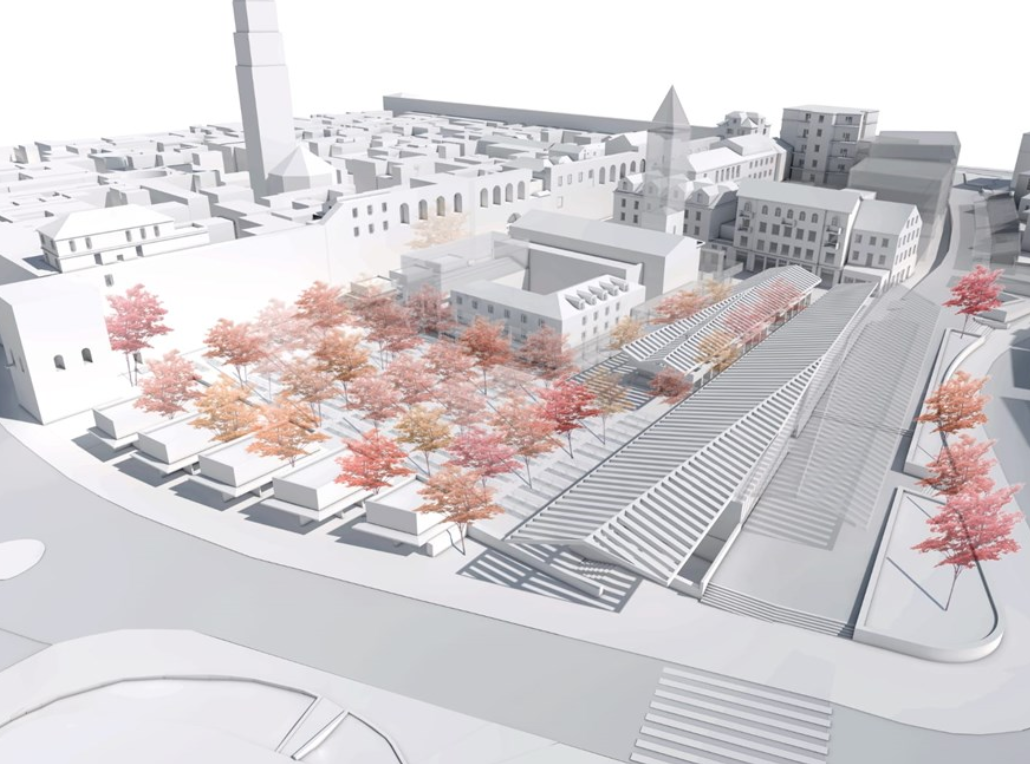
Of particular importance for pazar to function is opening the pedestrian traffic that is now blocked by kiosks, and Hrvojeva Street would be transformed into a full-width pedestrian zone. Sellers would only be allowed to operate with mobile equipment set up under strict guidelines.
The fish market, considering all the architectural options, would be expanded to Marmontova with a new section of the same height, and the old and the new part of the market would constitute one complete building. The front of the fish market requires a veranda that would protect customers at the entrance, protect the glass facades from the sun, and bring new quality to Marmontova’s public space. Thus, this upgraded section would become, as appropriate, a covered square used for other purposes outside the opening hours of the fish market.
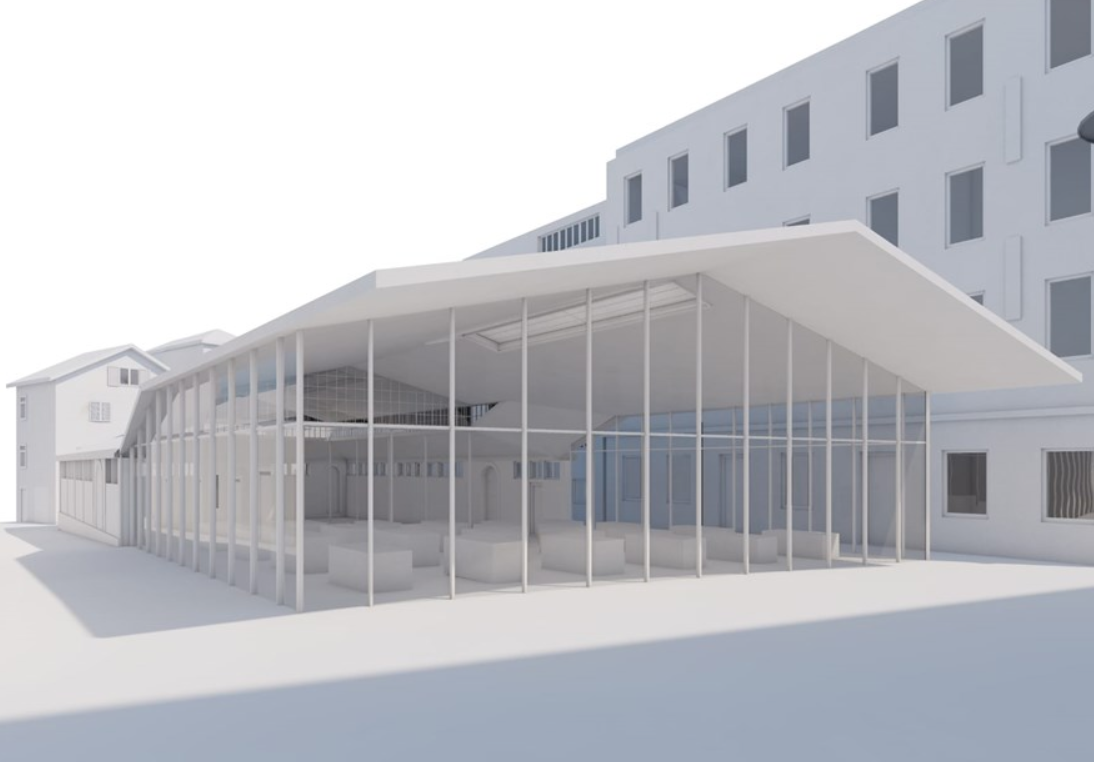
By expanding and opening the fish market, the city receives new content, based on all its traditional values. Its equipment would be adapted to the modern conditions of selling fish on stainless counters, and all necessary service facilities would be installed inside the fish market as a separate element.
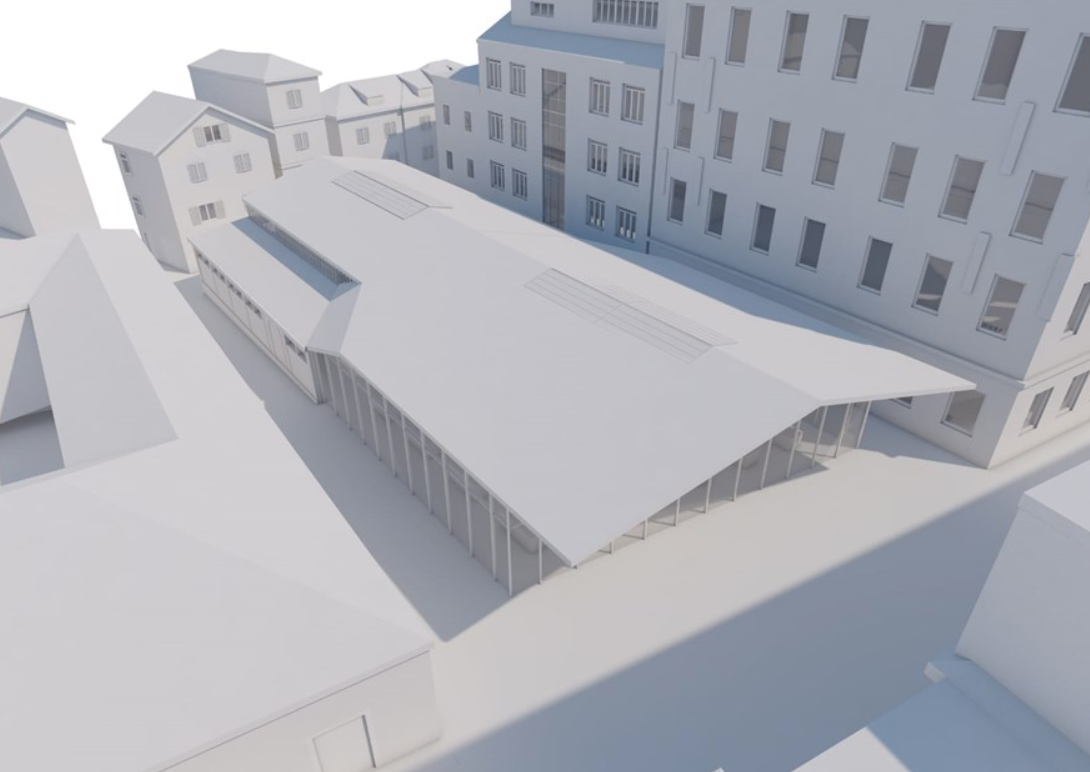
As Peracic emphasized, these are not finished conceptual designs, but more about the intelligence of the space, which contains everything necessary for the realization of these projects to succeed:
“It is important not to fall into complete solutions, but to see what is needed. We did it; this is the basis for the future design.”
"More detailed planning of the realization of these projects can now begin, we are considering the stages of renovation to enable its efficient realization, but more importantly, to ensure that the pazar and fish market operate during the works,” the mayor added.
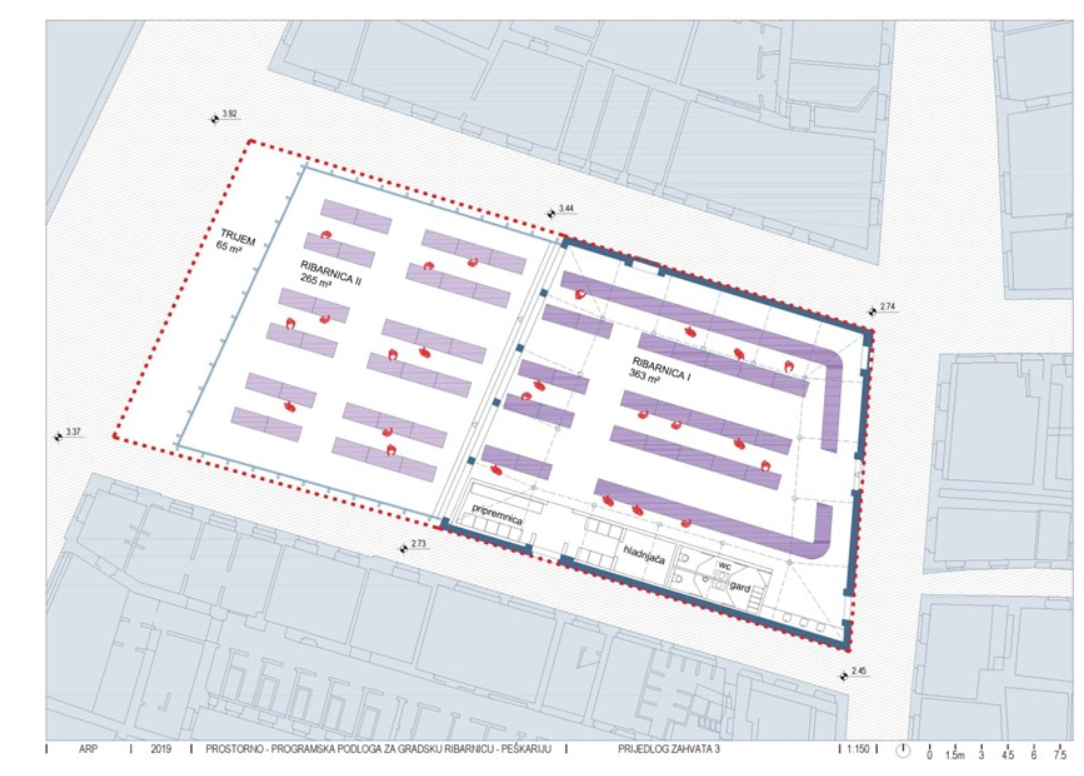
In order to qualitatively prepare for these renovations, several additional preliminary activities are planned before the next stages of the project documentation is prepared. These include detailed planning of terms of sales points in cooperation with the vendors, defining precise conditions for the development of architectural design in cooperation with the Conservation Department, making a snapshot of the existing state of the building and installations, preparing conservation studies, drafting project documentation through the procurement process, business plan and securing funding.
To read more about lifestyle in Croatia, follow TCN’s dedicated page.
Split Fish Market Moves Indoors, Sellers Banned from Outside
December 2, 2019 - Hippos, a concessionaire of the Split green market and fish market, have banned sellers in the outside part of the Split fish market.
Slobodna Dalmacija reports that from today, fish and seafood will no longer be sold in the outdoor area of the Split fish market, based on the decision by the State Inspectorate and the Veterinary Inspectorate.
The decision to close the outside area was made following the law that prohibits the sale of fish outdoors, i.e., permits the sale of fish only indoors.
Since the exterior of the fish market has only a prefabricated roof, this space is not legally adapted for the sale of fish. However, despite this fact, it should be noted that all fish sellers will get their place in the enclosed part of the fish market.

Thus, until further notice, the smell of fish will no longer permeate through Marmontova and the surrounding alleyways, and the famous street will be quieter without the sweet sounds of bargaining.
“There is room for everyone and no one will be neglected. All those who have been selling fish outside the fish market to date will be housed inside.
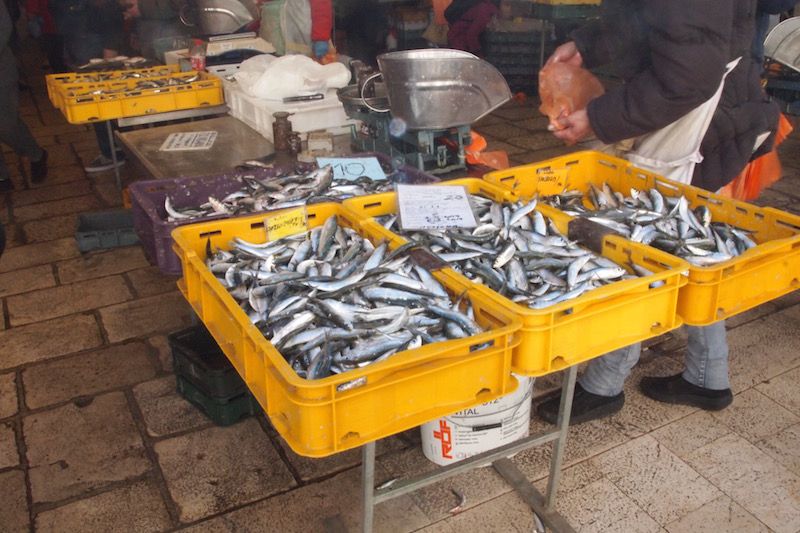
They may not have the guaranteed comfort as before, they will have to squeeze a little, but no one will be left without a place to sell.
We, as concessionaires of the Split fish market, will abide by all legal provisions, that is, all legally issued decisions,” promises Tvrtko Karoglan, director of Hippos, the concessionaire of the Split green market and fish market.
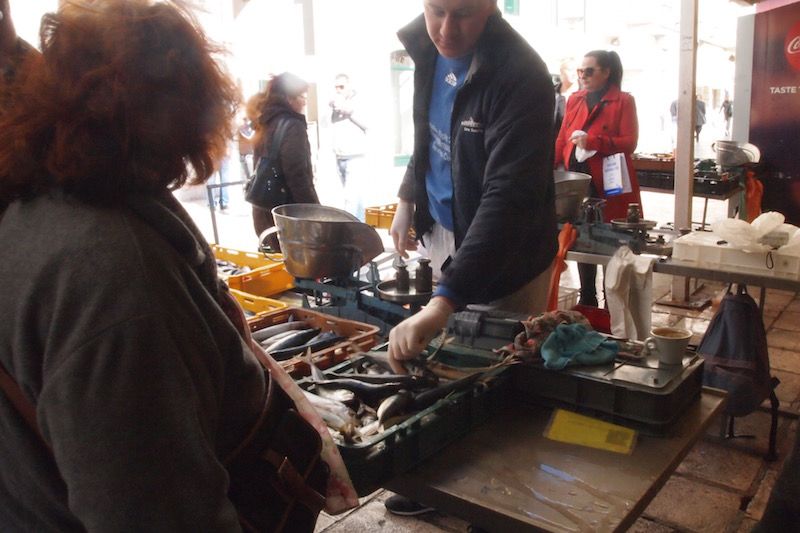
However, Karoglan points out that he will not give up on outdoor sales. That is, as the owner of the fish market, and with the City of Split and the competent conservation services, he will try to find a way to meet all legal standards to start selling fish outside again soon.
“The Split fish market is a part of the history of this city, and it will surely be unusual for many Split residents buying fish today,” says Karoglan.
Splitski Dnevnik writes that fishers are dissatisfied with this process and the Fishers’ Guild immediately held a meeting on the topic. The fishers voiced that they are concerned about what will happen to the surplus fish that cannot be sold inside due to the market's space, adding that it is necessary to review the decision on who can sell their fish at this market.
Fishers also said that there have been talks about renovating this area for several years, and that the funds have been secured from European funds, but nothing has happened.
The Split Fish Market is a stone building built around 1890. It is located on Marmontova, next to the Split spa. On the stone banks inside the fish market and in front of the fish market, fishers offer fresh fish, crustaceans, various types of shellfish, anchovies, sardines, and river fish daily.
For now, watching seagulls steal sardines from Marmontova will be a thing of the past, as is one of Split’s most famous attractions.
To read more about lifestyle in Croatia, follow TCN’s dedicated page.
What was Good Friday Like at the Fish Market?
Today is Good Friday, a day that is celebrated the Friday before Easter Sunday to commemorate Jesus Christ's crucifixion and death.
PHOTOS: Saturday Morning Fish Market Finds
Who said weekends at the fish market weren’t good?
This Morning at Split's Finest Establishment: The Fish Market
The fish market - or better known to locals as the "ribarnica" - is one of the most exciting places to visit in the city. From the early morning hours, fishermen fill the tables of the market with their freshest catch, and patrons argue loudly with the fishmongers to ensure they're getting the best price of the day.


